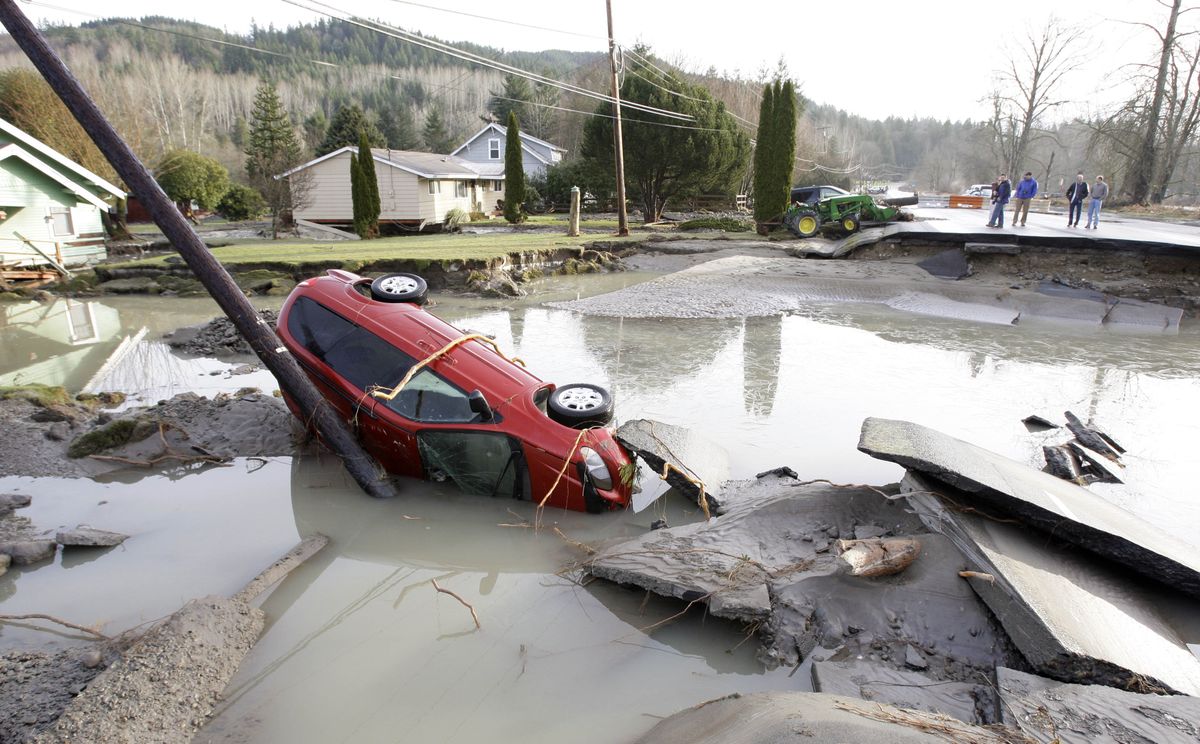West Side cleans up as flooding recedes
Gregoire estimates damage at $125 million after tour

CENTRALIA, Wash. – State officials began reopening Washington’s major highways on Friday as floodwaters receded and road crews plowed away mud, snow and debris. But flooding continued on a handful of major rivers, and residents of some low-lying areas were only beginning to tackle the cleanup of their sodden homes.
Flooding, mudslides and avalanches began closing highways and driving more than 30,000 people from their homes on Wednesday as a warm, wet storm blew across the state, bringing a combination of heavy rain and rapidly melting snow in the Cascade Mountains.
Gov. Chris Gregoire, who toured flooded areas Friday, gave what she called a very preliminary estimate of $125 million in damage to roads, buildings and other structures.
U.S. Transportation Secretary Mary Peters joined the tour, announcing $2 million in initial federal aid.
Gregoire said she also spoke by phone with President-elect Barack Obama, who assured her that aid to the state would be seamless during the transition to his administration.
High water closed Interstate 5 near Centralia, about halfway between Seattle and Portland, late Wednesday, while avalanches and the threat of more slides closed the state’s mountain passes, including Interstate 90 at Snoqualmie Pass, the major east-west route.
Along I-5, flooding wasn’t as bad as officials had feared. One dike on the Chehalis River was about an inch away from being overwhelmed when the river crested late Thursday night, said Don Wagner, a regional administrator for the state Transportation Department.
“Another inch of water and we could have had a different story,” he said. “We dodged a bullet.”
In flooding just 13 months ago, about a mile of the state’s major north-south freeway was under as much as 10 feet of water in the low-lying area south of Olympia. This year, flooding was confined to a few spots, with the deepest water measuring about 3 feet, Wagner said.
The state opened the freeway at noon Friday to escort long lines of freight trucks through the reopened areas to see how the roadway would react to the weight after having its foundations soaked.
Officials also plowed away avalanches to open I-90, which cuts east from Seattle through the Cascades. Of the two other major Cascade passes, U.S. 2 through Stevens Pass was reopened Thursday. U.S. 12 through White Pass had reopened Thursday to local traffic only but a section was closed again Friday for slide removal.
East of Seattle in Carnation, Bob Marcey watched with binoculars Friday as the water receded from the home where he and his family had to be rescued Wednesday.
“It felt like the world was coming to the end. But right now I have the biggest sigh of relief I’ve ever felt,” Marcey said. “The sun is breaking through. The water is receding very fast.”
Although drier weather was in the forecast, flood warnings remained in effect in several Western Washington counties, and the National Weather Service said major flooding was still occurring on the Snohomish River northeast of Seattle.
Many roads are still damaged and closed across the state, said Wagner, who figured the damage would run into the millions of dollars and end up more expensive than harm caused by last winter’s floods.
“I would like to request that Mother Nature not dump as much snow on us or quite as much water on us all at once,” Wagner said.
Freight train service returned to normal Friday on north-south tracks in Western Washington, said Gus Melonas, a spokesman for Burlington Northern Santa Fe, after crews removed mud and debris along the lines.
Limited Amtrak passenger train service both north and south of Seattle will resume this afternoon. Normal service was expected to resume Sunday.
Freight trains were able to travel east and west through the tunnel beneath Stevens Pass during the flooding and bad weather.
Gregoire, Peters and the state’s two U.S. senators, Patty Murray and Maria Cantwell, toured flooded areas Friday.
The governor, just back from a visit to Washington National Guard troops in Iraq, said the lack of deaths and major injuries from the severe weather reflected much greater willingness of people in flooded and flood-threatened areas to heed evacuation warnings.
Peters said the federal government was giving Washington $2 million as a down payment toward flood repairs, and that more money would be on the way once the state has specifics on the damage.
Opening the highways allowed the hundreds of truckers who pulled their rigs off onto highway shoulders or into packed truck stops to get back on the road. Stalled freight traffic costs the state’s economy millions of dollars per day.
State Transportation Secretary Paula Hammond estimated the economic effect of just the I-5 shutdown at about $10 million a day. A major storm 13 months ago closed the same stretch for four days.